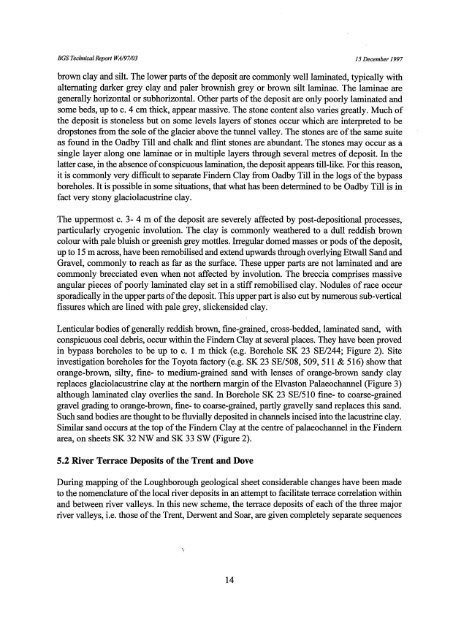Download (3723Kb) - NERC Open Research Archive - Natural ...
Download (3723Kb) - NERC Open Research Archive - Natural ...
Download (3723Kb) - NERC Open Research Archive - Natural ...
You also want an ePaper? Increase the reach of your titles
YUMPU automatically turns print PDFs into web optimized ePapers that Google loves.
BGS Technical Report WA/97/03<br />
15 December 1997<br />
brown clay and silt. The lower parts of the deposit are commonly well laminated, typically with<br />
alternating darker grey clay and paler brownish grey or brown silt laminae. The laminae are<br />
generally horizontal or subhorizontal. Other parts of the deposit are only poorly laminated and<br />
some beds, up to c. 4 cm thick, appear massive. The stone content also varies greatly. Much of<br />
the deposit is stoneless but on some levels layers of stones occur which are interpreted to be<br />
dropstones fiom the sole of the glacier above the tunnel valley. The stones are of the same suite<br />
as found in the Oadby Till and chalk and flint stones are abundant. The stones may occur as a<br />
single layer along one laminae or in multiple layers through several metres of deposit. In the<br />
latter case, in the absence of conspicuous lamination, the deposit appears till-like. For this reason,<br />
it is commonly very difficult to separate Findern Clay fiom Oadby Till in the logs of the bypass<br />
boreholes. It is possible in some situations, that what has been determined to be Oadby Till is in<br />
fact very stony glaciolacustrine clay.<br />
The uppermost c. 3- 4 m of the deposit are severely affected by post-depositional processes,<br />
particularly cryogenic involution. The clay is commonly weathered to a dull reddish brown<br />
colour with pale bluish or greenish grey mottles. Irregular domed masses or pods of the deposit,<br />
up to 15 m across, have been remobilised and extend upwards through overlying Etwall Sand and<br />
Gravel, commonly to reach as far as the surface. These upper parts are not laminated and are<br />
commonly brecciated even when not affected by involution. The breccia comprises massive<br />
angular pieces of poorly laminated clay set in a stiff remobilised clay. Nodules of race occur<br />
sporadically in the upper parts of the deposit. This upper part is also cut by numerous sub-vertical<br />
fissures which are lined with pale grey, slickensided clay.<br />
Lenticular bodies of generally reddish brown, fine-grained, cross-bedded, laminated sand, with<br />
conspicuous coal debris, occur within the Findern Clay at several places. They have been proved<br />
in bypass boreholes to be up to c. 1 m thick (e.g. Borehole SK 23 SE/244; Figure 2). Site<br />
investigation boreholes for the Toyota factory (e.g. SK 23 SE/508,509, 51 1 & 516) show that<br />
orange-brown, silty, fine- to medium-grained sand with lenses of orange-brown sandy clay<br />
replaces glaciolacustrine clay at the northern margin of the Elvaston Palaeochannel (Figure 3)<br />
although laminated clay overlies the sand. In Borehole SK 23 SE/5 10 fine- to coarse-grained<br />
gravel grading to orange-brown, fine- to coarse-grained, partly gravelly sand replaces this sand.<br />
Such sand bodies are thought to be fluvially deposited in channels incised into the lacustrine clay.<br />
Similar sand occurs at the top of the Findern Clay at the centre of palaeochannel in the Findern<br />
area, on sheets SK 32 NW and SK 33 SW (Figure 2).<br />
5.2 River Terrace Deposits of the Trent and Dove<br />
During mapping of the Loughborough geological sheet considerable changes have been made<br />
to the nomenclature of the local river deposits in an attempt to facilitate terrace correlation within<br />
and between river valleys. In this new scheme, the terrace deposits of each of the three major<br />
river valleys, i.e. those of the Trent, Derwent and Soar, are given completely separate sequences<br />
14
















